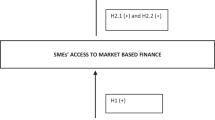Abstract
This study investigates the level of competition among commercial banks in Kenya over the period 2001 to 2014. The study used a balanced panel data set from 36 commercial banks, the performance dynamics approach and the generalized method of moments to estimate the resulting dynamic panel models. The investigation established that the level of competition among commercial banks in Kenya is low and characterized by 93.9 per percent persistence in profitability. Arising from the study findings, it is important that the government intervenes to rectify the intermediation inefficiency occasioned by ineffectiveness of competition. It is also important that small sized banks in the sector voluntarily merge with other smaller banks in order to exert substantial competition to the large and medium sized banks.


Similar content being viewed by others
Notes
There is now a growing liberation challenge that “Sub Saharan Africa” is no synonym to “Africa South of Sahara”, the former being considered socially demeaning and the latter geographically placing. See information to authors in http://www.jpanafrican.org/submission.htm
Being industry wide measures the λi are assumed to be common for all the commercial banks
This was necessitated by the fact that summary statistics of pooled series understate the standard deviation of firm invariant but time variant variables
References
Berger AN, Klapper LF, Turk-Ariss R (2009) Bank competition and financial stability. J Financ Serv Res 35(2):99–118
Blackburne EF, Frank MW (2007) Estimation of nonstationary heterogeneous panels. Stata J 7(2):197
Cable JR, Jackson RH (2008) The persistence of profits in the long run: a new approach. Int J Econ Bus 15(2):229–244
Cantwell J (2000) Innovation profits and growth: Schumpeter and Penrose, University of Reading. Department of Economics
Central Bank of Kenya (2001) Bank Supervision Annual Report (Seventh Edition) 2000. Central Bank of Kenya, Nairobi
Central Bank of Kenya (2006) Bank Supervision Annual Report (Twelve Edition) 2005. Central Bank of Kenya, Nairobi
Central Bank of Kenya (2011) Bank Supervision Annual Report 2010. Central Bank of Kenya, Nairobi
Central Bank of Kenya (2015) Bank Supervision Annual Report 2014. Central Bank of Kenya, Nairobi
Chronopoulos DK, Liu H, McMillan FJ, Wilson JO (2015) The dynamics of US bank profitability. Eur J Finan 21(5):426–443. https://doi.org/10.1080/1351847X.2013.838184
Elzinga KG, Mills DE (2011) The lerner index of monopoly power: origins and uses. Amer Econ Rev 101(3):558–564
Flamini V, Schumacher ML, McDonald MCA (2009) The determinants of commercial bank profitability in Sub-Saharan Africa. International Monetary Fund, Washington, pp 9–15
Goddard J, Liu H, Molyneux P, Wilson JO (2011) The persistence of bank profit. J Bank Finan 35(11):2881–2890
Gschwandtner A (2003) Profit persistence in the US: evidence from a new dataset. Department of Economics, University of Vienna
Gschwandtner A (2005) Profit persistence in the ‘very’ long run: Evidence from survivors and exiters. Appl Econ 37(7):793–806
Gudmundsson R, Ngoka-Kisinguh K, Odongo MT (2013) The Role of Capital Requirements on Bank Competition and Stability: The Case of the Kenyan Banking Industry. Kenya Bankers Association-KBA Centre for Research on Financial Markets and Policy Working Paper Series
Kamau A (2009) Efficiency and productivity of the banking sector in kenya: An empirical investigation. Unpublished PhD dissertation, University of Nairobi
Mitra-Kahn BH (2005) General Equilibrium Theory, its history and its relation (if any) to the Market Economy. City University, London The New School for Social Research, New York
Mueller DC (1977) The Persistence of Profits above the Norm. Economica 44 (176):369. https://doi.org/10.2307/2553570
Muniu J, Mburu T, Obere A (2015) The value Effects of Bank Mergers and Acquisitions in Kenya. LAP Lambert Academic Publishing
Pakes A (1987) Mueller’s profits in the long run
Panzar JC, Rosse JN (1987) Testing for “monopoly” equilibrium. The Journal of Industrial Economics, 443–456
Randall MR (1998) Interest rate spreads in the Eastern Caribbean. International Monetary Fund
Republic of Kenya (2008) First Medium Term Plan (2008-2012). Goverment Printer, Nairobi
Roodman D (2006) How to do xtabond2: An introduction to difference and system GMM in Stata. Center for Global Development working paper (103)
Sanya S, Gaertner M (2012) Assessing bank competition within the East African Community. International Monetary Fund, pp 12–32
Varian HR (2014) Intermediate Microeconomics: A Modern Approach: Ninth International Student Edition. WW Norton & Company, New York
Vives X (2010) Competition and stability in banking
Yurtoglu BB (2004) Persistence of firm-level profitability in Turkey. Appl Econ 36(6):615–625. https://doi.org/10.1080/0003684042000217652
Author information
Authors and Affiliations
Corresponding author
Rights and permissions
About this article
Cite this article
Mdoe, I.J., Omolo, J.O. & Wawire, N.H. Bank Competition in Kenya. J Ind Compet Trade 19, 83–102 (2019). https://doi.org/10.1007/s10842-018-0279-2
Received:
Revised:
Accepted:
Published:
Issue Date:
DOI: https://doi.org/10.1007/s10842-018-0279-2




